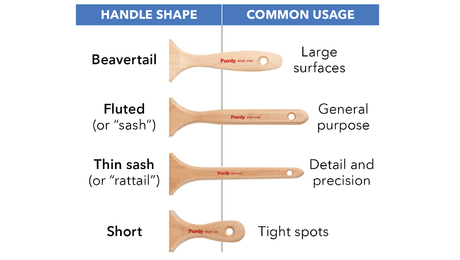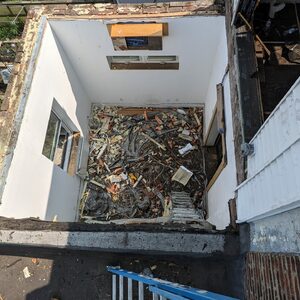*
We are building a hidden exterior shelving unit as part of a gridded plywood-and-batten wall in hot & humid Memphis, TN. We would appreciate a recommendation on the door material. The biggest door is 6’8″ x 3’6″, with concealed hinges on one side only, will be painted, and is mostly sheltered from direct rain but will get some during windy storms. To minimize weight, we’re hoping for a thickness between 3/8″ and 5/8″ but will use whatever it takes to prevent the door from twisting or cupping out of plane and not closing correctly.
Discussion Forum
Discussion Forum
Up Next
Video Shorts
Featured Story

Tips for picking the right paintbrush based on paint type, surface, and personal comfort.
Highlights
Fine Homebuilding Magazine
- Home Group
- Antique Trader
- Arts & Crafts Homes
- Bank Note Reporter
- Cabin Life
- Cuisine at Home
- Fine Gardening
- Fine Woodworking
- Green Building Advisor
- Garden Gate
- Horticulture
- Keep Craft Alive
- Log Home Living
- Military Trader/Vehicles
- Numismatic News
- Numismaster
- Old Cars Weekly
- Old House Journal
- Period Homes
- Popular Woodworking
- Script
- ShopNotes
- Sports Collectors Digest
- Threads
- Timber Home Living
- Traditional Building
- Woodsmith
- World Coin News
- Writer's Digest


















Replies
*
Hi Bill,
Since your door is to look like part of the wall, and your wall is plywood with battens, I think you already know the answer. Just make sure your plywood is exterior grade, and an A-C grade panel will be flatter than a CDX sheeting grade.
The battens screwed to the plywood door should help keep the door from bowing. Make sure that the entire door is properly sealed against moisture; this especially includes the top and bottom edges.
Do screw the battens on, don't nail them. The srews will give strength to the door, nails will simply pull loose if door wants to bow. To avoid plugging the screw holes, tack the battens in place with a few brad nails, then flop the door over and screw from the backside.
I would use 3/4 plywood, but you know best what you want. If I used 3/4, I could cut grooves or dadoes on rear side of door 1/4 inch deep and insert 1/4 inch thick hardwood battens, glued and screwed as an added means of support against bowing.
I would only add these extra strips if door started to show signs of misalignment. I truly believe the original battens screwed to the outside of the plywood door will most likely be enough reinforcement.
Just a thought.
Good luck.
Davo
*Hey Bill, A hollow core door will definately not warp, and although they are considerably thicker (1-3/8 inches), they will be much lighter than your plywood door.You could simply glue the battens on with gorrila glue or Franklin Titebond waterproof glue to give you the frontal visual effect(battens) you desire. If you paint the door, paint all surfaces. If staining, use a good spar varnish as a sealer.A plain mahogany (luan) HC slab door really will hold up if properly painted/sealed. If you need to match wood grain, use a HC Birch door.When I worked as a carpenter for a local steel mill, I was often given the job of replacing rusted, exterior metal doors with new ones. We always replaced them with wood doors. The majority of these doors we made were all hollow core style doors. We built a frame out of nominal stud grade lumber; which we planed down to 1-1/4 inches. The frame was a "crossbuck" design, with a middle lockrail and then the top half and bottom half each had half lapped "crosses" installed. The lockrail and half laps were held in place with corrugated fasteners, similiar to the type used to join miter joints in picture frames. We then glued a sheet of luan plywood to each side of this framework, and added some brad nails to help hold the sheets in place while the glue dried. Once dry, the door was very stiff. We hung the doors using 3inch strap hinges.Doors that I first installed over 8 years ago, and subject to heavy abuse by mill use, are still going strong. The key is to simply paint/seal these doors good before installing. What I'm getting at, is a HC door, whether store bought or home made, would remain straight and would be light weight, and yes they can definately hold up.Just a thought.Again, good luck on your project.Davo